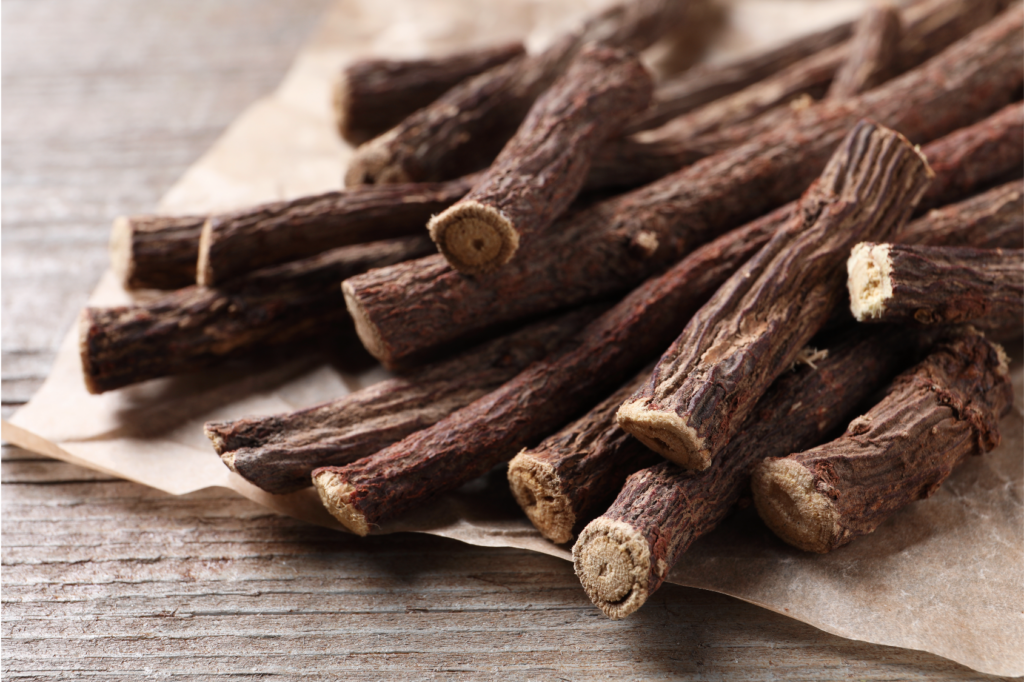By Kathy Abascal
Many of us love real licorice candy and enjoy licorice’s sweet flavor in various herbal teas. But few appreciate what an amazing and useful plant licorice is. Licorice has been used medicinally for thousands of years in both European and Asian traditions.
In traditional Chinese medicine (TCM), licorice is considered harmonizing because it moderates the actions of other herbs in beneficial ways. It has been called a wise elder statesman, and was important enough to be buried with a Chinese emperor. In Western medicine, licorice is used as an adaptogen. Adaptogens are special herbs that, when used long-term, help the body and the brain deal with stressors, whether physical or mental.
Licorice has a very long history of use for coughs, sore throats, stomach and duodenal ulcers, and hepatitis. The old Greek and Roman physicians used it to treat asthma and virtually all other lung diseases. It was used similarly in TCM, and modern research tends to confirm the wisdom of these uses.
Licorice is a demulcent that soothes irritated mucus membranes. It is antispasmodic and suppresses coughs very well, with an effect shown to be equal to, or better than, codeine. Licorice is one of the best herbs for children who suffer from frequent colds and coughs.
Licorice also has an antispasmodic effect on the stomach and intestines. In fact, licorice has many positive effects on the stomach, where it acts as an anti-acid, a demulcent to heal inflamed membranes, and as an antibacterial. These properties are useful in healing ulcers, and several clinical studies show that licorice effectively helps heal stomach and duodenal ulcers.
In most cases, the whole licorice root is used to heal ulcers, but deglycyrrhizinated licorice (DGL) tablets, where the compound glycyrrhizin has been removed, work equally well. Glycyrrhizin is what gives licorice its sweet taste; it is 50 times sweeter than sugar, but does not raise blood sugar levels. Glycyrrhizin is also responsible for much of licorice’s many antiviral effects. Preliminary studies showed glycyrrhizin to be quite effective at inhibiting severe acute respiratory syndrome, and also showed strong antiviral effects against its relative, COVID-19.
In China, licorice is used to treat chronic viral hepatitis, with a reported 70% success rate. Other in vitro studies show that licorice has a wide range of antiviral actions. This includes antimicrobial effects against influenza strains, including the worrisome H1N5 (worrisome because this strain of bird flu is now appearing in a variety of mammals).
The Japanese use isolated glycyrrhizin to moderate the patient’s immune function in human immunodeficiency virus infections, and to help suppress HIV replication. They have done several long-term studies showing that oral administration was quite effective; they also administer the compound intravenously and report that it effectively suppresses HIV levels. Although not studied, given the historical uses of licorice, whole licorice root should be beneficial here, as well. Licorice is also a common ingredient in many topical treatments for herpes simplex sores. Finally, glycyrrhizin has shown strong antibacterial effects, including against some antibiotic-resistant strains.
Glycyrrhizin should be used cautiously in those with a tendency to hypertension because it can cause the body to retain too much sodium and excrete too much potassium. This can lead to edema, hypertension, headaches, and sometimes cardiac dysfunction and severe hypertension. As a result, licorice is avoided in those with a history of heart or kidney problems, hypertension, and obesity. It is also to be avoided in pregnancy, and in those taking diuretics, stimulant laxatives, blood thinners, and various other prescription medications.
However, licorice side effects are not common. In TCM, licorice is an ingredient in many formulas and is viewed as nourishing, gentle, and safe for almost everyone. As well, no side effects were reported in the Japanese studies where glycyrrhizin was administered intravenously as treatment for HIV.
It may be that any risk associated with taking licorice can be avoided by consuming a healthy diet, rich in fruits and vegetables and other potassium-rich herbal teas. DGL is often used to avoid any possible licorice side effects, but DGL does not have the antimicrobial effects attributed to glycyrrhizin.
Much like marzipan, the taste of licorice is one that affects people differently. Most either love it or strongly dislike the taste. However, I have not found that these likes and dislikes reflect whether licorice might be beneficial for the individual. Instead, I think acquiring a taste for licorice might be well worth cultivating for many, as the benefits of licorice are so striking.

